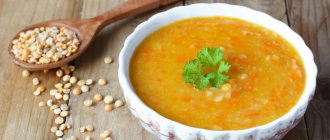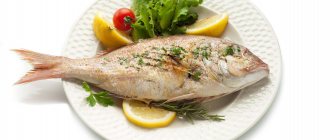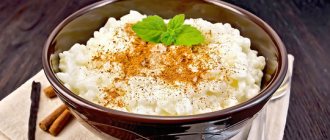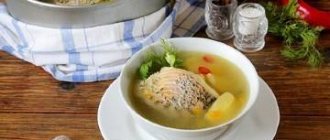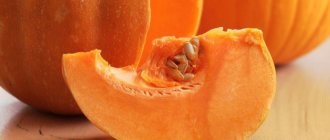Benefits for the child
100 g of fresh greens contains only 40 kcal. Dill contains fats, proteins, carbohydrates, vitamins, micro- and macroelements necessary for the child.
Chemical composition:
- Microelements: copper, iron, manganese, zinc;
- Vitamins: A, representatives of group B, C, E, PP and beta-carotene;
- Macroelements: magnesium, potassium, phosphorus, calcium, sodium.
Beta-carotene is a biochemical precursor of vitamin A. It helps strengthen the immune system due to its antioxidant properties and increases the child’s body’s ability to withstand stress. Vitamin A is necessary for a child for harmonious development and growth, as well as for the proper formation of visual functions. If this element is deficient, the baby may experience health problems:
- blurred vision;
- slow growth;
- anemia;
- poor appetite;
- high sensitivity of tooth enamel;
- peeling and dry skin, etc.
Sufficient intake of vitamin C (ascorbic acid) into the body is especially important during the growth period. It strengthens the immune system and protects against various viruses. With regular consumption, it prevents inflammation and allergic reactions. If this vitamin is not enough in the menu, problems with gums and teeth may appear. Vitamin C is essential for children attending kindergarten, where they encounter various infections every day.
Calcium is the most important component of a child’s bones. If its quantity is insufficient, violations are observed:
- growth retardation;
- defective formation of teeth;
- increased muscle tone;
- disruptions in the functioning of the heart.
Calcium deficiency is indicated by brittle nails, weak tooth enamel and poor hair condition.
Magnesium is necessary for a growing body for full growth and development, strengthening bones. Dental health and blood sugar levels largely depend on it. During the growth period, magnesium consumption is at its highest, so parents should ensure that the baby receives a sufficient amount of this element with food.
Copper is involved in the formation of bone and connective tissue, ensures the elasticity of blood vessels and skin, increases the ability to resist certain infections and enhances the effect of antibiotics.
Regular consumption of dill reduces the likelihood of skin rashes, irritation and food allergies in a child. The baby’s nervous system will work better if these fresh greens are included in his diet. It will have a beneficial effect on the gastrointestinal tract and prevent indigestion.
When to introduce greens into your baby's diet?
A popular myth claims that a child can refuse breastfeeding if the mother eats garlic, onions and herbs. Surveys show that grandmothers are scary, but the child “listens and eats” and for some reason is in no hurry to squeamishly refuse milk with a changed smell.
Parsley and dill in grated form are added to the baby’s diet from seven months. As already mentioned, when the structure of a plant is destroyed, a significant amount of valuable substances is simply lost. Therefore, it is much more useful to give your child a sprig of one or another greenery to chew whole. For one, you will check if your baby is allergic to greens.
Onions and garlic are introduced after 8-10 months , if the child still has digestive problems (stool problems, skin rashes), it is better to move them even further. Greens are quite difficult to digest; to facilitate digestion, they should be doused with boiling water before serving.
Other greens - sorrel, spinach, dandelion, nettle, cilantro, etc. - are introduced no earlier than one and a half years ! Unfortunately, these beneficial herbs affect kidney function.
The norm for greens is 3-5 g per day, this amount is quite capable of satisfying the need for the necessary macroelements. An excess of ordinary greens, especially if it is a salad of different herbs, threatens with irritable bowel syndrome; its symptoms are similar to poisoning. Popularly this disease is called “stomach rash.” Therefore, be sure to ensure that your child does not overeat a variety of greens at the dacha.
Nutrients are absorbed along with fat, so dishes with greens should contain vegetable oil (sunflower, olive or corn).
How and at what age should I give it?
Photo: Depositphotos.com. Author: tanya_ischenko.
Dill is introduced into children's diets from 8 months of age. It is unlikely that the baby himself will express a desire to eat it, so the mother will have to try. The easiest way is to add 5 g to the soup. You can grind the dill using a blender along with vegetables, getting an excellent homemade puree.
After 1.5 years, you can increase the daily consumption to 10 g. At this age, the baby can easily eat dill, in addition to soup, also as part of various vegetable salads. And by chopping the greens with meat broth, you will get an appetizing and healthy gravy for the second course.
Arugula
This beautiful herb has become very popular in our latitudes in recent years. The slight bitterness of arugula is given by essential oils, including mustard oil, an excellent source of essential fatty acids Omega-3 and Omega-9. Arugula increases appetite, has antibacterial properties, normalizes water-salt balance, and according to some data protects the walls of the stomach from irritation. By the way, it is highly recommended to eat arugula regularly if you have diabetes, as it can lower blood sugar levels. Thanks to its excellent balance of iron and ascorbic acid, arugula helps maintain normal hemoglobin levels.
- It is recommended to offer arugula in its raw form, for example in the form of a salad, to children no earlier than 1.5-2 years.
Source: Burda Media
Harm and contraindications
Dill greens in childhood are not always and not everyone is allowed. The first days after introducing a new product to the children's menu, you need to carefully monitor the baby's reaction.
- In some children, the essential oils contained in the herb can provoke a severe allergic reaction.
- Frequent use is contraindicated if you have low blood pressure, as some substances in greens can aggravate the condition and cause fainting.
- In large quantities, this aromatic seasoning can worsen intestinal function and disrupt bowel movements.
Purchasing early greens for baby feeding is not advisable. To ensure rapid growth, plants are fertilized with dangerous substances, including nitrates, which can cause poisoning in a child. Therefore, it is better to wait until the season for collecting from open ground. For central Russia this is the beginning of summer.
How it affects the body
Fresh dill contains a lot of essential oils, carotene, iron, magnesium, sodium salts, calcium, copper, ascorbic acid, and B vitamins. Its regular use helps the active breakdown of food, strengthens the visual apparatus, normalizes fat and carbohydrate metabolism, and ensures proper functioning of the nervous system. systems.
The complex of minerals in dill helps the development of muscle, connective tissue, skeletal bones, and maintain the elasticity of vascular walls.
If a child eats dill just like that, he may be lacking trace elements or vitamins. Those who are accustomed to adding greens to their dishes all year round are less likely to suffer from inflammatory processes, irritation of the mucous membranes, colds and other infections.
Due to its saturation with volatile oils, fresh dill cannot be eaten in large quantities. In children, excessive consumption of greens can cause bloating, severe pain, and vomiting. Symptoms of pseudo-allergy are also likely: skin rash, swelling of the tonsils, lacrimation, runny nose.
Dill can cause harm in acute or chronic gastrointestinal pathologies: pancreatitis, gastritis, colitis, cholecystitis.
Procurement for future use
The most popular harvesting methods are drying and freezing.
- Dried herbs are suitable for hot dishes, especially soups. During cooking, it acquires its original appearance, while retaining almost all its beneficial properties. Dry it in bunches, hanging it in a dry, well-ventilated and dark room.
- For salads, it is recommended to freeze dill. With proper storage and subsequent thawing, it will remain quite juicy, and most of the taste and nutritional qualities will be preserved. The greens are finely chopped, packed in sealed bags and placed in the freezer.
Other greens
For the full development of a child without the use of vitamin complexes, pediatricians recommend adding other greens to food.
- Parsley is rich in vitamin C, so it effectively protects the baby from infections, has pronounced antiseptic properties and improves blood condition.
- Spinach contains a lot of calcium, which strengthens your baby's bones and teeth. No less important for a growing fidget is the high concentration of protein in the green leaves of the plant. It is not recommended to add spinach to baby food more than twice a week.
- Young sorrel leaves will help diversify your child’s menu. They have a beneficial effect on intestinal function and have strong anti-inflammatory properties.
Reviews from parents
Maria. After my daughter’s second birthday, she started giving her greens. Our relatives advised us as they watched us leave the hospital for the third time in two years after complications from a cold. At first she added a little to salads, and then she became interested in eating straight from the garden. My daughter especially loved dill. Now the child is 5 years old, and she is almost never sick. Even if she catches the virus during an epidemic, she survives it easily and without consequences. Irina. From the very beginning of complementary feeding, I made all the baby’s purees myself. From about 7 months I started adding a little dill to the blender, literally 2 cm from the branch. By the age of one, my son was already eating salads with these greens and was happy when he caught them from the soup. The eldest, looking at his brother, also sometimes began to chew dill sprigs, although he had always refused before. The baby has never been sick yet.
Tamara. Dill and parsley are my twins' favorite food additions. I started giving it when the children were one year old, because they are allergic, but before I was afraid. Fortunately, the greens did not cause any reaction. The kids are already in their third year, and they get the necessary vitamins from what grows around the house. For the winter, we dry a decent supply and add it to salads, soups and main courses. Probably, it was thanks to this that the adaptation to kindergarten took place without sick leave.
Is it possible to give parsley to a child?
Healing properties of parsley
Parsley began to be used for medicinal purposes back in Ancient Greece. It is still used today.
Traditional medicine recommends:
- A compress with freshly squeezed green juice will help with bruises. It needs to be changed after 4 hours. This advice is relevant for parents of restless children, whose bruises are a common occurrence.
- A lotion with fresh parsley juice should be applied to a wasp or bee sting. You can apply a leaf softened to a paste to the mosquito bites.
- For childhood infections (measles, scarlet fever, chicken pox), it is recommended to prepare for children a healing, strengthening infusion of fresh or dried herbs or their roots. To do this you need to take 1 tbsp. l. chopped leaves (or 1 teaspoon of root, crushed in a blender) for 1 glass of boiling water, let it brew (can be in a thermos) for 6-8 hours. The strained infusion is recommended for children to take 1 tsp, and for older children - 1 tbsp. l. 0.5 hour before feeding the baby up to 4 times a day. The infusion can also be used during the seasonal increase in colds.
- To combat flatulence, the infusion is prepared as follows: 5 tsp. parsley seeds (pre-chopped) should be poured with chilled boiled water in a volume of 200 ml, let it brew under the lid for 2-3 hours. Take the strained infusion 1 tsp. 30 minutes before meals 3-4 times a day. The infusion will help increase appetite.
- To strengthen hair in case of excessive hair loss, you can use ointment. First 2 tbsp. l. seeds need to be boiled in a glass of water until sour cream thickens. After cooling, you need to add 2 tbsp. l. melted butter or pork fat, mix well. The ointment is applied to the scalp half an hour before washing.
- Parsley can help eliminate bad breath. This is achieved by destroying bacteria, which is responsible for the appearance of such a smell.
The use of traditional medicine recipes must be coordinated with a pediatrician, who will take into account all the characteristics of the child’s body.
